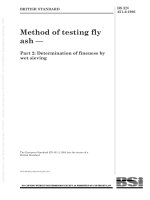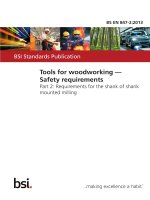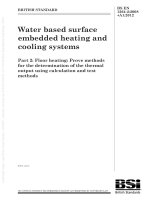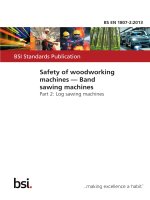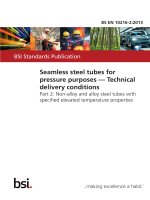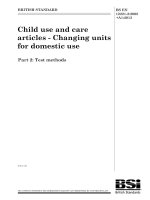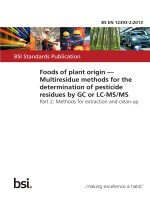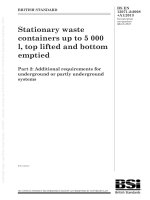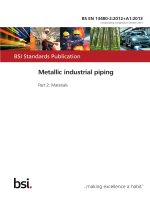Bsi bs en 62361 2 2013
Bạn đang xem bản rút gọn của tài liệu. Xem và tải ngay bản đầy đủ của tài liệu tại đây (1.52 MB, 54 trang )
BS EN 62361-2:2013
BSI Standards Publication
Power systems management
and associated information
exchange — Interoperability
in the long term
Part 2: End to end quality codes for supervisory
control and data acquisition (SCADA)
BRITISH STANDARD
BS EN 62361-2:2013
National foreword
This British Standard is the UK implementation of EN 62361-2:2013. It is
identical to IEC 62361-2:2013.
The UK participation in its preparation was entrusted to Technical
Committee PEL/57, Power systems management and associated
information exchange.
A list of organizations represented on this committee can be obtained on
request to its secretary.
This publication does not purport to include all the necessary provisions of
a contract. Users are responsible for its correct application.
© The British Standards Institution 2014.
Published by BSI Standards Limited 2014
ISBN 978 0 580 53001 2
ICS 33.200
Compliance with a British Standard cannot confer immunity from
legal obligations.
This British Standard was published under the authority of the
Standards Policy and Strategy Committee on 31 January 2014.
Amendments/corrigenda issued since publication
Date
Text affected
BS EN 62361-2:2013
EN 62361-2
EUROPEAN STANDARD
NORME EUROPÉENNE
EUROPÄISCHE NORM
December 2013
ICS 33.200
English version
Power systems management and associated information exchange Interoperability in the long term Part 2: End to end quality codes for supervisory control and data
acquisition (SCADA)
(IEC 62361-2:2013)
Gestion des systèmes de puissance et
échanges d'informations associés Interopérabilité à long terme Partie 2: Codes de qualité de bout en bout
pour le contrôle de supervision et
acquisition de données (SCADA)
(CEI 62361-2:2013)
Angleichung der Codes für die
Datenqualität innerhalb des TC 57 Allgemeine Liste der Codes für die
Datenqualität
(IEC 62361-2:2013)
This European Standard was approved by CENELEC on 2013-10-30. CENELEC members are bound to comply
with the CEN/CENELEC Internal Regulations which stipulate the conditions for giving this European Standard
the status of a national standard without any alteration.
Up-to-date lists and bibliographical references concerning such national standards may be obtained on
application to the CEN-CENELEC Management Centre or to any CENELEC member.
This European Standard exists in three official versions (English, French, German). A version in any other
language made by translation under the responsibility of a CENELEC member into its own language and notified
to the CEN-CENELEC Management Centre has the same status as the official versions.
CENELEC members are the national electrotechnical committees of Austria, Belgium, Bulgaria, Croatia, Cyprus,
the Czech Republic, Denmark, Estonia, Finland, Former Yugoslav Republic of Macedonia, France, Germany,
Greece, Hungary, Iceland, Ireland, Italy, Latvia, Lithuania, Luxembourg, Malta, the Netherlands, Norway, Poland,
Portugal, Romania, Slovakia, Slovenia, Spain, Sweden, Switzerland, Turkey and the United Kingdom.
CENELEC
European Committee for Electrotechnical Standardization
Comité Européen de Normalisation Electrotechnique
Europäisches Komitee für Elektrotechnische Normung
CEN-CENELEC Management Centre: Avenue Marnix 17, B - 1000 Brussels
© 2013 CENELEC -
All rights of exploitation in any form and by any means reserved worldwide for CENELEC members.
Ref. No. EN 62361-2:2013 E
BS EN 62361-2:2013
EN 62361-2:2013
-2-
Foreword
The text of document 57/1374/FDIS, future edition 1 of IEC 62361-2, prepared by IEC/TC 57, "Power
systems management and associated information exchange" was submitted to the IEC-CENELEC
parallel vote and approved by CENELEC as EN 62361-2:2013.
The following dates are fixed:
•
latest date by which the document has
to be implemented at national level by
publication of an identical national
standard or by endorsement
(dop)
2014-07-30
•
latest date by which the national
standards conflicting with the
document have to be withdrawn
(dow)
2016-10-30
Attention is drawn to the possibility that some of the elements of this document may be the subject of
patent rights. CENELEC [and/or CEN] shall not be held responsible for identifying any or all such
patent rights.
Endorsement notice
The text of the International Standard IEC 62361-2:2013 was approved by CENELEC as a European
Standard without any modification.
BS EN 62361-2:2013
EN 62361-2:2013
-3-
Annex ZA
(normative)
Normative references to international publications
with their corresponding European publications
The following documents, in whole or in part, are normatively referenced in this document and are
indispensable for its application. For dated references, only the edition cited applies. For undated
references, the latest edition of the referenced document (including any amendments) applies.
NOTE When an international publication has been modified by common modifications, indicated by (mod), the relevant EN/HD
applies.
Publication
Year
IEC 60870-5
Series Telecontrol equipment and systems Part 5: Transmission protocols
EN 60870-5
Series
IEC 60870-6
Series Telecontrol equipment and systems
EN 60870-6
Series
IEC 61850
Series Communication networks and systems in
substations
EN 61850
Series
IEC 61850-3
IEC 61850-7-2
IEC 61850-7-3
IEC 61970
IEC 61970-301
ISO 8601
-
Title
Communication networks and systems for
power utility automation Part 3: General requirements
2010 Communication networks and systems for
power utility automation Part 7-2: Basic information and
communication structure - Abstract
communication service interface (ACSI)
-
Communication networks and systems for
power utility automation Part 7-3: Basic communication structure Common data classes
Series Energy management system application
program interface (EMS-API)
-
2004
OPC Data Access version 2.03; www.opcfoundation.org.
OPC UA Part 8 -Data Access RC 1.01.10 Specification.doc
At draft stage.
FprEN 61850-3
Year
1)
-
EN 61850-7-2
2010
EN 61850-7-3
-
EN 61970
Energy management system application
FprEN 61970-301
program interface (EMS-API) Part 301: Common information model (CIM)
base
Data elements and interchange formats Information interchange - Representation of
dates and times
DAIS Data Access formal/05-06-01; www.omg.com
1)
EN/HD
Series
1)
-
-
–2–
BS EN 62361-2:2013
62361-2 © IEC:2013
CONTENTS
INTRODUCTION ..................................................................................................................... 7
1
Scope ............................................................................................................................... 8
2
Normative references ....................................................................................................... 8
3
Terms and definitions ....................................................................................................... 9
4
Overview of applicable IEC standards .............................................................................. 9
5
Quality code flow diagram from substation to control center ........................................... 10
6
List of quality codes by existing standards ...................................................................... 12
6.1
6.2
7
Comparison of quality codes in existing standards................................................. 12
IEC 60870-5-101/ IEC 60870-5-104 quality codes ................................................. 14
6.2.1 Data related quality ................................................................................... 14
6.2.2 Timestamp and related quality ................................................................... 14
6.3 IEC 60870-5-103 quality codes .............................................................................. 15
6.4 IEC 60870-6 (TASE.2) quality codes ..................................................................... 15
6.4.1 Data related quality ................................................................................... 15
6.4.2 Timestamp and related quality ................................................................... 16
6.5 IEC 61850 quality codes (from IEC 61850-7-3) ...................................................... 17
6.5.1 Data related quality ................................................................................... 17
6.5.2 Quality in the client server context ............................................................. 19
6.5.3 Relation between quality identifiers ........................................................... 21
6.5.4 Timestamp and related quality ................................................................... 22
6.6 IEC 61970-301 quality codes ................................................................................. 24
6.6.1 General ..................................................................................................... 24
6.6.2 MeasurementValueQuality Attributes defined in IEC 61970-301................. 24
6.6.3 MeasurementValueSource naming conventions ......................................... 25
6.7 OPC and OMG quality codes ................................................................................. 26
6.7.1 OPC DA quality codes ............................................................................... 26
6.7.2 DAIS Data Access Quality codes ............................................................... 28
6.7.3 Timestamp and related quality ................................................................... 32
6.8 OPC UA Data Access Status Codes ...................................................................... 33
6.8.1 Overview ................................................................................................... 33
6.8.2 Operation level result codes ...................................................................... 33
Mapping of quality codes between standards .................................................................. 34
8
7.1 General ................................................................................................................. 34
7.2 Mapping from IEC 61850 to IEC 60870-5-101/ IEC 60870-5-104 ........................... 34
7.3 Mapping from IEC 60870-5-101/IEC 60870-5-104 to IEC 61970-301 ..................... 36
7.4 Mapping from IEC 61850 to IEC 61970-301 ........................................................... 37
7.5 Mapping from IEC 60870-6 to IEC 61970-301 ........................................................ 39
7.6 Mapping from IEC 61970-301 to IEC 60870-6 ........................................................ 40
7.7 Mapping from IEC 61850 to DAIS DA and OPC DA ............................................... 42
Common quality codes across the power systems information exchange standards ........ 44
8.1
8.2
Common quality codes .......................................................................................... 44
Quality code definitions ......................................................................................... 44
8.2.1 Validity quality codes ................................................................................. 44
8.2.2 Detailed quality codes ............................................................................... 45
BS EN 62361-2:2013
62361-2 © IEC:2013
8.2.3
8.2.4
8.2.5
–3–
Additional quality codes ............................................................................. 48
Timestamp related quality codes ............................................................... 48
Source quality codes ................................................................................. 48
Figure 1 – Overview IEC power systems information exchange standards .............................. 9
Figure 2 – Example of quality code flow diagram from substation to remote control
center ................................................................................................................................... 11
Figure 3 – Quality type definitions ......................................................................................... 17
Figure 4 – Quality identifiers in a single client – server relationship ...................................... 20
Figure 5 – Quality identifiers in a multiple client – server relationship ................................... 20
Figure 6 – Interaction of substitution and validity .................................................................. 22
Figure 7 – MeasurementValueQuality attributes inherited from IEC 61850 ............................ 25
Figure 8 – OMG DAIS quality codes ...................................................................................... 30
Table 1 – Overview of quality codes in existing standards ..................................................... 13
Table 2 – Validity attribute values ......................................................................................... 16
Table 3 – CurrentSource attribute values .............................................................................. 16
Table 4 – NormalSource attribute values .............................................................................. 16
Table 5 – NormalValue attribute values................................................................................. 16
Table 6 – DetailQual relation to invalid or questionable ......................................................... 18
Table 7 – TimeStamp type definition ..................................................................................... 23
Table 8 – TimeQuality definition excerpt from IEC 61850-7-2:2010, Table 8 ......................... 23
Table 9 – TimeAccuracy excerpt from IEC 61850-5:2013, Table 9 ........................................ 24
Table 10 – Example MeasurementValueSource naming conventions .................................... 25
Table 11 – Lower 8 bits of OPC DA quality flags ................................................................... 26
Table 12 – OPC standard quality BitField definition .............................................................. 26
Table 13 – Substatus for BAD quality .................................................................................... 27
Table 14 – Substatus for UNCERTAIN quality ....................................................................... 27
Table 15 – Substatus for GOOD quality ................................................................................ 28
Table 16 – Limit BitField contents ......................................................................................... 28
Table 17 – OPCQuality members .......................................................................................... 30
Table 18 – Quality, status and limit bit masks ....................................................................... 30
Table 19 – Main quality enumerations ................................................................................... 30
Table 20 – Detailed quality flags for bad quality .................................................................... 31
Table 21 – Detailed quality flags for uncertain quality ........................................................... 31
Table 22 – Definition of limit flags ......................................................................................... 31
Table 23 – DAIS masks ........................................................................................................ 32
Table 24 – DAIS flags defining source .................................................................................. 32
Table 25 – Timestamp for DAIS quality flags ......................................................................... 32
Table 26 – Bad operation level result codes .......................................................................... 33
Table 27 – Uncertain operation level result codes ................................................................. 33
Table 28 – Good operation level result codes ....................................................................... 34
Table 29 – Mapping from IEC 61850 to IEC 60870-5-101/IEC 60870-5-104 .......................... 35
Table 30 – Mapping from IEC 60870-5-101/IEC 60870-5-104 to IEC 61970-301 ................... 36
–4–
BS EN 62361-2:2013
62361-2 © IEC:2013
Table 31 – Mapping from IEC 61850 to IEC 61970-301 ......................................................... 38
Table 32 – Mapping from IEC 60870-6 to IEC 61970-301 ...................................................... 39
Table 33 – Mapping from IEC 61970-301 to IEC 60870-6 ...................................................... 41
Table 34 – Mapping from IEC 61850 to DAIS DA and OPC DA ............................................. 42
Table 35 – Validity quality codes ........................................................................................... 45
Table 36 – Detailed good quality codes ................................................................................. 45
Table 37 – Detailed invalid quality codes .............................................................................. 46
Table 38 – Detailed questionable quality codes .................................................................... 47
Table 39 – Additional quality codes ....................................................................................... 48
Table 40 – Timestamp quality codes ..................................................................................... 48
Table 41 – Process and substituted quality codes ................................................................. 49
BS EN 62361-2:2013
62361-2 © IEC:2013
–7–
INTRODUCTION
The scope of IEC 62361-2 is to create a common list of SCADA quality codes for reference by
other standards to avoid embedding quality code lists in other standards.
–8–
BS EN 62361-2:2013
62361-2 © IEC:2013
POWER SYSTEMS MANAGEMENT
AND ASSOCIATED INFORMATION EXCHANGE –
INTEROPERABILITY IN THE LONG TERM –
Part 2: End to end quality codes for supervisory control
and data acquisition (SCADA)
1
Scope
This part of IEC 62361 documents the quality codes used by existing IEC standards related to
supervisory control and data acquisition (SCADA) in the field of power systems management.
Meter reading quality coding is not considered to be in the scope of this version of the
document. It determines and documents mapping between these standards. Eventual loss of
quality information that might occur in mapping is documented. A cohesive and common list of
quality codes with semantics is defined. The identified standards to be dealt with in this
document are: IEC 60870-5, IEC 60870-6 TASE.2, IEC 61850, IEC 61970, DAIS DA, OPC DA
and OPC UA.
Data covered by this part of IEC 62361 is measurements provided by the following links,
applications or interfaces:
•
RTU, 61850 or OPC DA links to SCADA
•
Validation added by state estimation
•
TASE.2 (ICCP) or TASE.1 (ELCOM) links between control centers
•
Servers, e.g. SCADA, that provide OPC or DAIS DA-data.
2
Normative references
The following documents, in whole or in part, are normatively referenced in this document and
are indispensable for its application. For dated references, only the edition cited applies. For
undated references, the latest edition of the referenced document (including any
amendments) applies.
IEC 60870-5 (all parts), Telecontrol equipment and systems – Part 5: Transmission protocols
IEC 60870-6 (all parts), Telecontrol equipment and systems – Part 6: Telecontrol protocols
compatible with ISO standards and ITU-T recommendations
IEC 61850 (all parts), Communication networks and systems for power utility automation
IEC 61850-3, Communication networks and systems for power utility automation – Part 3:
General requirements
IEC 61850-7-2:2010, Communication networks and systems for power utility automation –
Part 7-2: Basic information and communication structure – Abstract communication service
interface (ACSI)
IEC 61850-7-3, Communication networks and systems for power utility automation – Part 7-3:
Basic communication structure – Common data classes
IEC 61970 (all parts), Energy management system application program interface (EMS-API)
BS EN 62361-2:2013
62361-2 © IEC:2013
–9–
IEC 61970-301, Energy management system application program interface (EMS-API) –
Part 301: Common information model (CIM) base
ISO 8601, Data elements and
Representation of dates and times
interchange
formats
–
Information
interchange
DAIS Data Access formal/05-06-01; www.omg.com
OPC Data Access version 2.03; www.opcfoundation.org.
OPC UA Part 8 -Data Access RC 1.01.10 Specification.doc
3
Terms and definitions
No special terms or definitions are required to understand this document.
Overview of applicable IEC standards
IEC 61968
Control Center A
IT-System
EMS
apps.
DMS
apps.
IEC 61970
IEC 61968
Control Center B
IEC 61968
IT-System
Communication Bus
SCADA
Inter-CC Datalink
RTU
IEC 61970
IEC 60870-6
Inter-CC Datalink
IEC 61850
IEC 61970
IEC 60870-6-TASE.2
IEC 61970
IEC 60870-5-101/104
4
Substation
Substation
Automation
System
IEC 60870-5-103
IEC 61850
Protection, Control, Metering
IEC 61850
Switchgear, Transformers,
Intrumental Transformers
IEC
Figure 1 – Overview of IEC power systems information exchange standards
2213/13
–
– 10 –
BS EN 62361-2:2013
62361-2 © IEC:2013
Figure 1 provides an overview of the IEC power systems information exchange standards.
Refer to IEC/TR 62357-1 (Power systems management and associated information exchange
– Part 1: Reference architecture) for further information.
When data is transmitted using a telecommunications protocol, the quality of the data must be
preserved, and have a common meaning on both side of the transmission.
To facilitate harmonization and simplify maintenance of the standards, all IEC standards in
the field of power systems management and associated information exchange should refer to
this standard regarding quality codes. Specifications for quality codes should not be
developed in the other standards. Upcoming revisions of this document can then work to
harmonize quality codes across several standards.
5
Quality code flow diagram from substation to control center
IEC power systems information exchange standards for substation communication, control
center communication and communication standards intended for exchange of information
between applications at the control center level do have their own quality codes.
The quality codes flow through this chain of hierarchical systems from the IED to the control
center. The quality codes need to be mapped between these standards. As different
standards do not today support the same quality codes and semantics definitions for quality
codes are not identical in the standards, mapping is difficult and loss of quality information
can likely happen.
Figure 2 provides an example of the quality code flow diagram from substation to remote
control center.
BS EN 62361-2:2013
62361-2 © IEC:2013
Value, Quality and
Source can be:
System
– 11 –
Value
-Validity
-Quality
-Time stamp
-Time Quality
-Source
Protocol/mapping
Control Center B
System
IEC 61970
Control Center B
Protocol/mapping
Control Center B Inter-CC link
IEC 60870-6
Value
-Validity
-Quality
-Time stamp
-Time Quality
-Source
System
Protocol/mapping
Control Center A Inter-CC link
Value, Quality and
Source can be:
System
Control Center A
IEC 60870-6
Value
-Validity
-Quality
-Time stamp
-Time Quality
-Source
Control Center A
Protocol/mapping
IEC 61970
IEC 60870-5-101/104
Value, Quality and
Source can be:
System
Substation
Value
-Validity
-Quality
-Time stamp
-Time Quality
-Source
Protocol/mapping
1)
IEC 61850
Substation
IEC
2214/13
Figure 2 – Example of quality code flow diagram from substation
to remote control center
NOTE
A number of systems with multiple Client-Server relationships can also exist within the substation
The primary purpose of the quality code is to provide information to applications and users of
control systems if a value is good or not.
Most standards also have detailed quality codes that can help applications decide if
questionable values can be used or provide information why a value is Invalid and cannot be
used.
Some applications utilize the time stamp of values. Time quality codes must be provided to
indicate if the time stamp can be used. For special applications also the time accuracy of the
time stamp is relevant.
In addition to quality codes most standards have source quality that gives information about
the origin of the value. Quality codes and value can also be set by local supervision functions
or by operator input in systems in the acquisition chain.
– 12 –
BS EN 62361-2:2013
62361-2 © IEC:2013
Quality codes are important in the maintenance of control systems and are used to identify
erroneous signals in the control systems. The quality codes should if possible indicate what
type of failure has occurred.
Test activities in substations during commissioning and maintenance will generate values that
are not “real”. The quality code test should indicated that these of values are not for
operational use.
6
6.1
List of quality codes by existing standards
Comparison of quality codes in existing standards
Table 1 provides an overview of quality codes in existing standards.
BS EN 62361-2:2013
62361-2 © IEC:2013
– 13 –
Table 1 – Overview of quality codes in existing standards
Quality
information
IEC and OMG SCADA related protocols:
IEC 60870-5101/104
IEC 60870-6
TASE.2
Overflow
OutofRange
BadReference
Oscillatory
Invalid/Counter
reading invalid
-
Failure
-
IEC 61850
Data/Information related quality
Good
Validity-good
Invalid
Validity-invalid
DAIS DA
OPC DA
Validity-valid
Validitynotvalid
-
Good
Good
Bad
Bad
-
-
Device failure
Device
failure
Configuration
error
Not
connected
Sensor
failure
Comm failure
Last known
value
Out of
service
Configuration error
Not connected
Sensor failure
Comm failure
Last known value
Out of service
Questionable
Not
topical/Counter
not adjusted
Validitysuspect
Uncertain
OutofRange
-
-
Engineering units
exceeded
Validityquestionable
BadReference
-
-
Sensor not accurate
Oscillatory
-
-
Quality ocillatory
OldData
-
-
Last usable value
Uncertain
Engineering
units
exceeded
Sensor not
accurate
Last usable
value
Sub-normal
Sensor not
accurate
Inconsistent
-
-
Sub-normal
Inaccurate
-
-
Sensor not accurate
Data source related information
Source-process
Process
(4)
SourceSubstituted
substituted
-
-
-
Sourcetelemetered
Source process
-
Source-entered
Primary substituted
Local
override (5)
Calculated
-
-
Estimated
-
-
-
Substituted
Sourcecalculated
Sourceestimated
-
-
Defaulted
Additional data quality information
Test
Test
-
-
OperatorBlocked
Blocked (1)
Validity-held
OperatorBlocked
Test
Timestamp related quality
Source-corrected
Source inherited
substituted
Remote defaulted
-
TEST_MASK
OPERATOR_BLOCK
ED_MASK
-
Invalid time
ClockFailure
Invalid time
TS_ACC_BAD_TIME
-
Clock not
synchronized
ClockNot
synchronized
Time stamp
quality
-
-
-
-
TimeAccuracy
TimeAccuracy
-
-
TS_ACC_10_MSEC
TS_ACC_100_MSEC
TS_ACC_SECOND
-
NOTE 1
Blocking and deblocking may be initiated e.g. by a local lock or a local automatic function.
NOTE 2 A correlation function has detected that the value is not consistent with other data. Typically set by a
network state estimator.
– 14 –
BS EN 62361-2:2013
62361-2 © IEC:2013
NOTE 3 Value has been replaced by state estimator (This is an additional quality code and not an enumeration of
source).
NOTE 4
Source Process is defined to be from process I/O or calculated by some application function.
NOTE 5
Validity shall be GOOD when code Local Override is set.
6.2
6.2.1
IEC 60870-5-101/ IEC 60870-5-104 quality codes
Data related quality
The following quality bits are used for single point information, double point information, step
position information, bitstring of 32 bit and measured value:
O VERFLOW /N O OVERFLOW (OV)
The value of the information object is beyond a predefined range of value (mainly applicable
to analogue values).
B LOCKED / NOT BLOCKED (BL)
The value of the information object is blocked for transmission; the value remains in the state
that was acquired before it was blocked. Blocking and deblocking may be initiated e.g. by a
local lock or a local automatic cause.
S UBSTITUTED / NOT SUBSTITUTED (SB)
The value of the information object is provided by input of an operator (dispatcher) or by an
automatic source.
N OT TOPICAL / TOPICAL (NT)
A value is topical if the most recent update was successful. It is not topical if it was not
updated successfully during a specified time interval or it is unavailable.
I NVALID / VALID (IV)
A value is valid if it was correctly acquired. After the acquisition function recognizes abnormal
conditions of the information source (missing or non operating updating devices) the value is
then marked invalid. The value of the information object is not defined under this condition.
The mark invalid is used to indicate to the destination that the value may be incorrect and
cannot be used.
TEST (T)
Test - classifies the value as being a test value and not to be used for operational purposes.
The following quality bits are used for integrated totals:
CARRY/NO CARRY (CY)
Counter overflow occurred in the corresponding integration period/no counter overflow
occurred in the corresponding integration period
COUNTER WAS ADJUSTED/ COUNTER WAS NOT ADJUSTED (CA)
Counter was adjusted since last reading/Counter was not adjusted since last reading
INVALID/VALID (IV)
Counter reading is invalid/Counter reading is valid
Although these quality bits are defined in the IEC 60870-5-101/ IEC 60870-5-104 standards,
many implementations don’t support all quality bits. Support IV and OV quality bits for
measured values and IV bit for the other data types can be considered to be mandatory.
6.2.2
Timestamp and related quality
The short timestamp format is a three octet short time stamp format, CP24Time2a.
BS EN 62361-2:2013
62361-2 © IEC:2013
– 15 –
7
Milliseconds
B
B 15
Milliseconds
B8
B
0
Three octet binary time
Milliseconds 0..59 999 ms
Minutes 0..59 min
IV = Invalid time, Res = Spare bit
IV
Res
B
5
Minutes
B
0
The full timestamp format is a seven octet binary time stamp format, CP56Time2a.
B7
Milliseconds
B0
B 15
Milliseconds
B8
Milliseconds 0..59 999 ms
IV = Invalid time, Res = Spare bit
IV
Res1
SU
B
B5
Res2
2
B
Day of week
Minutes
B6
Minutes 0..59 min
Hours 0..23 h
B4
Hours
B0
B4
Day of month
B0
Days of week 1..7 (Not used = 0)
B0
Months 1..12
B0
Years 0..99
0
Days of month 1..31
B3
Res3
Res4
B0
Months
Years
SU=1 …Summer time (local time used, not UTC time)
Time stamp source:
RES1=GEN for Genuine time or Substituted time (specified in Edition 2).
Timestamp related quality:
INVALID TIME (IV)
The time stamp is invalid
6.3
IEC 60870-5-103 quality codes
Available quality bits are limited compared to quality bits defined in IEC 60870-5–101/
IEC 60870-5-104. Example - Quality bits for measurands:
O VERFLOW /N O OVERFLOW (OV)
Measured value overflow / no overflow
ERROR (ER) (INVALID)
Measured value invalid / measured value valid
6.4
IEC 60870-6 (TASE.2) quality codes
6.4.1
6.4.1.1
Data related quality
Validity
The Validity attribute shown in Table 2 specifies the validity or quality of its associated
PointValue. This is based on the source system's interpretation as shown in Table 2:
– 16 –
BS EN 62361-2:2013
62361-2 © IEC:2013
Table 2 – Validity attribute values
Validity
Description
VALID
Data value is valid
HELD
The previous data value has been held over. Interpretation is local
SUSPECT
Data value is questionable. Interpretation is local
NOTVALID
Data value is not valid
6.4.1.2
CurrentSource
The CurrentSource attribute shown in Table 3 specifies the current source of the PointValue
data it is associated with:
Table 3 – CurrentSource attribute values
CurrentSource
Description
TELEMETERED
The data value was received from a telemetered site
CALCULATED
The data value was calculated based on other data values
ENTERED
The data value was entered manually
ESTIMATED
The data value is estimated (State Estimator, etc.)
6.4.1.3
NormalSource
The NormalSource attribute shown in Table 4 specifies the normal source of the PointValue
data it is associated with:
Table 4 – NormalSource attribute values
NormalSource
Description
TELEMETERED
The data value is normally received from a telemetered site
CALCULATED
The data value is normally calculated based on other data values
ENTERED
The data value is normally entered manually
ESTIMATED
The data value is normally estimated (State Estimator, etc.)
6.4.1.4
NormalValue
The NormalValue attribute shown in Table 5 reports whether value of the PointValue attribute
is normal. One bit is set, defined as shown in Table 5:
Table 5 – NormalValue attribute values
NormalValue
Description
NORMAL
The point value is that which has been configured as normal for the point
ABNORMAL
The point value is not that which has been configured as normal for the point
6.4.2
Timestamp and related quality
The following Timestamp attributes provide additional clarification and definition for the
timestamp quality used in the TASE.2 quality codes.
a) TimeStampClass attribute – has the value TIMESTAMP or TIMESTAMPEXTENDED if
the IndicationPoint is time stamped, and has the value NOTIMESTAMP if the
IndicationPoint contains no TimeStamp attribute.
BS EN 62361-2:2013
62361-2 © IEC:2013
– 17 –
b) TimeStamp attribute – provides a time stamp (with a minimum resolution of one second)
of when the value (attribute PointRealValue, PointStateValue or PointDiscreteValue) of the
IndicationPoint was last changed. It is set at the earliest possible time after collection of
the IndicationPoint value from the end device.
c) TimeStampExtended attribute – provides a time stamp (with a resolution of one
millisecond) of when the value (attribute PointRealValue, PointStateValue or
PointDiscreteValue) of the IndicationPoint was last changed. It is set at the earliest
possible time after collection of the IndicationPoint value from the end device.
d) TimeStampQuality attribute – has the value VALID if the current value of the TimeStamp
attribute contains the time stamp of when the value was last changed, and has the value
INVALID at all other times.
UTC Time is used in IEC 60870-6.
6.5
IEC 61850 quality codes (from IEC 61850-7-3)
6.5.1
Data related quality
Quality type shall be as defined as shown in Figure 3:
Figure 3 – Quality type definitions
IEC
2215/13
The DEFAULT value shall be applied, if the functionality of the related attribute is not
supported. The mapping may specify to exclude the attribute from the message, if it is not
supported or if the DEFAULT value applies.
Quality shall be an attribute that contains information on the quality of the information from
the server. The different quality identifiers are not independent. Basically, there are the
following quality identifiers:
–
validity
–
source
–
test
–
operatorBlocked
NOTE 1
server.
The quality, as used within the scope of 61850, is related to the quality of the information from the
There may be a requirement that the client uses additional quality information within its local database. This is a
local issue and not part of the scope of IEC 61850. However, the quality of a client may have an impact on the
quality supplied by a server of a client – server relationship at a higher level (see Figure 6).
BS EN 62361-2:2013
62361-2 © IEC:2013
– 18 –
The following quality type attributes provide additional clarification and definition for the data
related quality.
1) validity
Validity shall be good, questionable or invalid.
a) good: The value shall be marked good if no abnormal condition of the acquisition
function or the information source is detected.
b) invalid: The value shall be marked invalid when an abnormal condition of the
acquisition function or the information source (missing or non-operating updating
devices) is detected. The value shall not be defined under this condition. The mark
invalid shall be used to indicate to the client that the value may be incorrect and shall
not be used.
EXAMPLE If an input unit detects an oscillation of one input it will mark the related information as invalid.
c) questionable: The value shall be marked questionable if a supervision function
detects an abnormal behavior, however the value could still be valid. The client shall
be responsible for determining whether or not values marked "questionable" should be
used.
2) detailQual
The reason for an invalid or questionable value of an attribute may be specified in more
detail with further quality identifiers. If one of these identifiers is set then validity shall be
set to invalid or questionable. Table 6 shows the relation of the detailed quality identifiers
with invalid or questionable quality.
Table 6 – DetailQual relation to invalid or questionable
DetailQual
Invalid
Questionable
Overflow
X
Out of Range
X
X
Bad Reference
X
X
Oscillatory
X
X
Failure
X
Old data
X
Inconsistent
X
Inaccurate
X
a) Overflow: this identifier shall indicate a quality issue that the value of the attribute to
which the quality has been associated is beyond the capability of being represented
properly (used for measurand information only).
EXAMPLE A measured value may exceed the range that may be represented by the selected data type,
for example the data type is a 16-bit unsigned integer and the value exceeds 65 535.
b) outOfRange: this identifier shall indicate a quality issue that the attribute to which the
quality has been associated is beyond a predefined range of values. The server shall
decide if validity shall be set to invalid or questionable (used for measurand
information only).
EXAMPLE: A measured value may exceed a predefined range, however the selected data type can still
represent the value, for example the data type is a 16-bit unsigned integer, the predefined range is 0 to
40 000, if the value is between 40 001 and 65 535 it is considered to be out of range.
c) badReference: this identifier shall indicate that the value may not be a correct value
due to a reference being out of calibration. The server shall decide if validity shall be
set to invalid or questionable (used for measurand information and binary counter
information only).
d) oscillatory: to prevent overloading of event driven communication channels, it is
desirable to detect and suppress oscillating (fast changing) binary inputs. If a signal
changes in a defined time (tosc) twice in the same direction (from 0 to 1 or from 1 to 0)
then it shall be defined as an oscillation and the detail quality identifier “oscillatory”
BS EN 62361-2:2013
62361-2 © IEC:2013
– 19 –
shall be set. If a configured numbers of transient changes is detected, they shall be
suppressed. In this time, the validity status "questionable” shall be set. If the signal is
still in the oscillating state after the defined number of changes, the value shall be left
in the state it was in when the oscillatory bit was set. In this case, the validity status
"questionable” shall be reset and “invalid” shall be set as long as the signal is
oscillating. If the configuration is such that all transient changes should be suppressed,
the validity status “invalid” shall be set immediately in addition to the detail quality
identifier “oscillatory” (used for status information only).
e) failure: this identifier shall indicate that a supervision function has detected an internal
or external failure.
f) oldData: a value shall be oldData if an update is not made during a specific time
interval. The value may be an old value that may have changed in the meantime. This
specific time interval may be defined by an allowed-age attribute.
NOTE 2 "Fail silent" errors, where the equipment stops sending data will cause an oldData condition. In
this case, the last received information was correct.
g) inconsistent: this identifier shall indicate that an evaluation function has detected an
inconsistency.
h) inaccurate: this identifier shall indicate that the value does not meet the stated
accuracy of the source.
EXAMPLE: The measured value of power factor may be noisy (inaccurate) when the current is very small.
3) source
Source shall give information related to the origin of a value. The value may be acquired
from the process or be a substituted value.
a) process: the value is provided by an input function from the process I/O or is
calculated from some application function.
b) substituted: the value is provided by input of an operator or by an automatic source.
NOTE 3 Substitution may be done locally or via the communication services. In the second case, specific
attributes with a FC SV are used.
NOTE 4 There are various means to clear a substitution. As an example, a substitution that was done
following an invalid condition may be cleared automatically if the invalid condition is cleared. However, this
is a local issue and therefore not in the scope of this standard.
4) test
Test shall be an additional identifier that may be used to classify a value being a test
value and not to be used for operational purposes. The processing of the test quality in the
client shall be a local issue. The bit shall be completely independent from the other bits
within the quality descriptor.
The test identifier should normally be propagated through all hierarchical levels.
5) operatorBlocked: this identifier shall be set if further update of the value has been
blocked by an operator. The value shall be the information that was acquired before
blocking. If this identifier is set then the identifier oldData of detailQual shall also be set.
NOTE 5 Both an operator as well as an automatic function may block communication updating as well as
input updating. In both cases, detailQual.oldData will be set. If the blocking is done by an operator, then the
identifier operatorBlocked is set additionally. In that case, an operator activity is required to clear the
condition.
EXAMPLE An operator may block the update of an input, to save the old value, if the auxiliary supply is
switched off.
6.5.2
Quality in the client server context
– 20 –
BS EN 62361-2:2013
62361-2 © IEC:2013
IEC
2216/13
Figure 4 – Quality identifiers in a single client – server relationship
The quality identifier shall reflect the quality of the information in the server, as it is supplied
to the client. Figure 4 shows potential sources that may influence the quality in a single client
– server relationship. "Information Source" is the (hardwired) connection of the process
information to the system. The information may be invalid or questionable as indicated in
Figure 4. Further abnormal behavior of the information source may be detected by the input
unit. In that case, the input unit may keep the old data and flag it accordingly.
In a multiple client - server relationship, as shown in Figure 5, information may be acquired
over a communication link (with Client B). If that communication link is broken, client B will
detect that error situation and qualify the information as questionable/old data.
Figure 5 – Quality identifiers in a multiple client – server relationship
IEC
2217/13
In the multiple client-server relationship, the quality of the server A shall reflect both the
quality of the server B (acquired with client B) as well as its own quality. Therefore, handling
of prioritization of quality from different levels may require further specification beyond that
included in this standard. For the identifier validity, the value invalid shall dominate over the
value questionable, since this is the worst case. For the identifier source, the higher level of
the multiple client–server relationship shall dominate over the lower level.
EXAMPLE Let A be the higher level and B the lower level. The quality from server B is invalid. If now the
communication fails (questionable, oldData) between server B and client B, the quality will remain invalid and not
become questionable, since the last information was not correct. Server A therefore will report the information as
invalid.
BS EN 62361-2:2013
62361-2 © IEC:2013
6.5.3
– 21 –
Relation between quality identifiers
Validity and source have a prioritized relation. If source is in the “process” state, then validity
shall determine the quality of the origin value. If source is in the “substitute” state, then
validity shall be overruled by the definition of the substituted value. This is an important
feature, since substitution is used to replace invalid values with substituted values that may
be used by the client such as good values.
EXAMPLE 1: If both questionable and substituted are set, this means that the substituted value is questionable.
This may happen if, in a hierarchical configuration, a substitution is performed at the lowest level and the
communication fails on a higher level.
EXAMPLE 2: If an invalid value is substituted, the invalid field will be cleared and the substituted field will be set to
indicate the substitution.
The quality identifier operatorBlocked is independent of the other quality identifiers.
EXAMPLE 3: An oscillating input may cause the invalid field to be set. Due to the continuing changes in the value
many reports are generated, loading the communication network. An operator may block the update of the input. In
this case the field operatorBlocked will also be set.
An example for the interaction between the quality identifiers and the impact of multiple
client–server relations is shown in Figure 6. In this example, it is assumed that a bay level
device acts as a client of the process level server and as a server to the station level client.
NOTE This is one example of a multiple client – server relationship; other multiple client-server relationships may
exist, but the behavior will not change.
In case A, the input is blocked, the quality of the information is marked as questionable and
oldData.
In case B, a substitution is done at process level. Now, the quality of the information to the
next higher level (the bay level) is marked as substituted (but good).
In case C, the communication between process and bay level fails. Between bay level and
station level, the information is still marked as substituted. In addition, questionable and
oldData is set to indicate that the (substituted) information may be old.
In case D, a new substitution is made at bay level. Now the quality of the information to the
next higher level is marked as substituted (and good) and is independent from the first
substitution.
– 22 –
BS EN 62361-2:2013
62361-2 © IEC:2013
IEC
2218/13
Figure 6 – Interaction of substitution and validity
6.5.4
6.5.4.1
Timestamp and related quality
General
The time and time-synchronization model shall provide the UTC synchronized time to
applications located in server and client utility IEDs. The components of the time and time
synchronization model are depicted in Clause 21 and Figure 46 of IEC 61850-7-2:2010.
6.5.4.2
TimeStamp syntax
The TimeStamp type shall represent a UTC time with the epoch of midnight (00:00:00) of
1970-01-01 specified in Table 7.
BS EN 62361-2:2013
62361-2 © IEC:2013
– 23 –
Table 7 – TimeStamp type definition
The Timestamp attributes shown in Table 7 provide additional clarification and definition for
the timestamp quality used in the IEC 61850 quality codes.
1) SecondSinceEpoch – shall be the interval in seconds continuously counted from the
epoch1970-01-01 00:00:00 UTC.
NOTE 3
SecondSinceEpoch corresponds with the Unix epoch.
2) FractionOfSecond – shall be the fraction of the current second when the value of the
TimeStamp has been determined. The fraction of second shall be calculated as (SUM
from I = 0 to 23 of bi*2**–(I+1) s).
NOTE 4 The resolution is the smallest unit by which the time stamp is updated. The 24 bits of the integer
provides 1 out of 16777216 counts as the smallest unit; calculated by 1/2**24 which equals approximately
60 ns.
NOTE 5 The resolution of a time stamp may be 1/2**1 (= 0,5 s) if only the first bit is used; or may be
1/2**2 (= 0,25 s) if the first two bits are used; or may be approximately 60 ns if all 24 bits are used. The
resolution provided by an IED is outside the scope of this standard.
6.5.4.3
Timestamp related quality (as described in IEC 61850-7-2)
The TimeQuality shall provide information about the time source of the sending IED. The
TimeQuality definition is shown in Table 8.
Table 8 – TimeQuality definition excerpt from IEC 61850-7-2:2010, Table 8
The following points 1) to 4) provide additional clarification and definition for the attributes
shown in Table 8.
1) LeapSecondsKnown: The value TRUE of the attribute LeapSecondsKnown shall indicate
that the value for SecondSinceEpoch takes into account all leap seconds occurred. If it is
FALSE then the value does not take into account the leap seconds that occurred before
the initialization of the time source of the device.
NOTE 6 Leap Second - an intercalary second added to Coordinated Universal Time to compensate for the
slowing of the earth's rotation and keep Coordinated Universal Time in synchrony with solar time
2) clockFailure: The attribute ClockFailure shall indicate that the time source of the sending
device is unreliable. The value of the TimeStamp shall be ignored.

